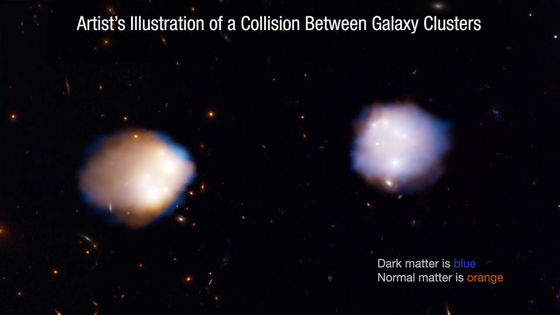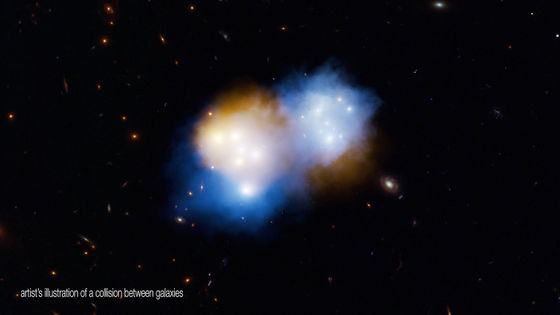It is discovered that 'dark matter' has been separated from ordinary matter due to the collision of galaxy clusters, and the speed difference between dark matter and ordinary matter has been observed for the first time.

When two trucks collide, any cargo that is not secured to the platform is thrown off the truck. Similarly, astronomers have announced that they have succeeded in capturing a phenomenon in which dark matter, which cannot be observed by normal means, is separated from ordinary matter when two massive galaxy clusters collide.
ICM-SHOX. I. Methodology Overview and Discovery of a Gas–Dark Matter Velocity Decoupling in the MACS J0018.5+1626 Merger - IOPscience
Dark Matter Flies Ahead of Normal Matter in Mega Galaxy Cluster Collision - www.caltech.edu
https://www.caltech.edu/about/news/dark-matter-flies-ahead-of-normal-matter-in-mega-galaxy-cluster-collision
Astronomers Witness Dark Matter Go Rogue in Epic Galaxy Cluster Collision : ScienceAlert
https://www.sciencealert.com/astronomers-witness-dark-matter-go-rogue-in-epic-galaxy-cluster-collision
In a paper published in The Astrophysical Journal, an academic journal published by the American Astronomical Society, a research team including Emily Silich, a researcher in astronomy at the California Institute of Technology, USA, announced that they had found that ordinary matter and dark matter moved at different speeds in the astronomical phenomenon called 'MACS J0018.5+1626'.
According to the research team, this is the first time that the speed difference between dark matter and ordinary matter has been directly analyzed.
In MACS J0018.5+1626, two massive galaxy clusters collided, and the large amounts of interstellar gas in each cluster collided, creating superheated turbulence. As a result, normal matter slowed down, but the dark matter in each cluster barely slowed down at all and passed through them, separating them.
Click on the video below to see an animation of the separation of ordinary matter and dark matter in MACS J0018.5+1626.
Dark Matter and Normal Matter Decouple - YouTube
Dark matter and ordinary matter move together in the two approaching galaxy clusters.

As the distance gets closer, dark matter (blue) precedes regular matter (orange).

Finally, when the galaxy clusters collide, both dark matter and ordinary matter are affected by gravity, but ordinary matter is slowed down by electromagnetic interactions and other factors, and this difference in speed causes the dark matter and ordinary matter to separate.

'Imagine a major accident in which two dump trucks transporting sand collide,' said lead author Silic of the paper. 'The dark matter would fly forward just like the sand in the dump trucks.'
This is not the first time that such a phenomenon has been observed; a particularly well-known example is the '
In the Bullet Cluster, the distribution of mass captured by gravitational lensing (colored blue) is misaligned with the position of the X-ray-emitting gas (colored red). This is taken as direct evidence of the existence of dark matter, a type of matter that is gravitationally active but cannot be observed.

Unlike the Bullet Cluster, in MACS J0018.5+1626, the subject of this study, one of the colliding galaxy clusters is moving toward Earth, while the other is moving away from Earth.
'Observing the Bullet Cluster is like watching a car race, where you can stand in the stands and take snapshots of the cars racing by in front of your eyes,' said Jack Sayers of California Institute of Technology, co-author of the paper and principal investigator of the study. 'Observing MACS J0018.5+1626 is like standing on the track with a speed gun, where you can stand in front of the cars coming towards you and measure their speed.'

To measure the speed of galaxy clusters, the team used a phenomenon called
By using the kinetic SZ effect, which exploits the Doppler shift caused by the motion of galaxy clusters, the team was able to determine the speed of the hot gas clouds that make up most of the mass of ordinary matter in galaxy clusters.
On the other hand, galaxy clusters are so massive that when they collide, most of the stars simply pass through each other without colliding with or changing speed, similar to the behavior of dark matter, which has almost no physical interactions with other objects.
Using this, the team was able to determine the difference in speed between ordinary matter and dark matter in MACS J0018.5+1626.

by WM Keck Observatory/Adam Makarenko
The findings from this study are expected to be a powerful tool in investigating the true nature of dark matter in the future. 'This study is the starting point for more detailed studies of the properties of dark matter,' said Silic. 'In other words, we now have a new probe that can directly investigate how dark matter behaves differently from ordinary matter.'
Related Posts:







